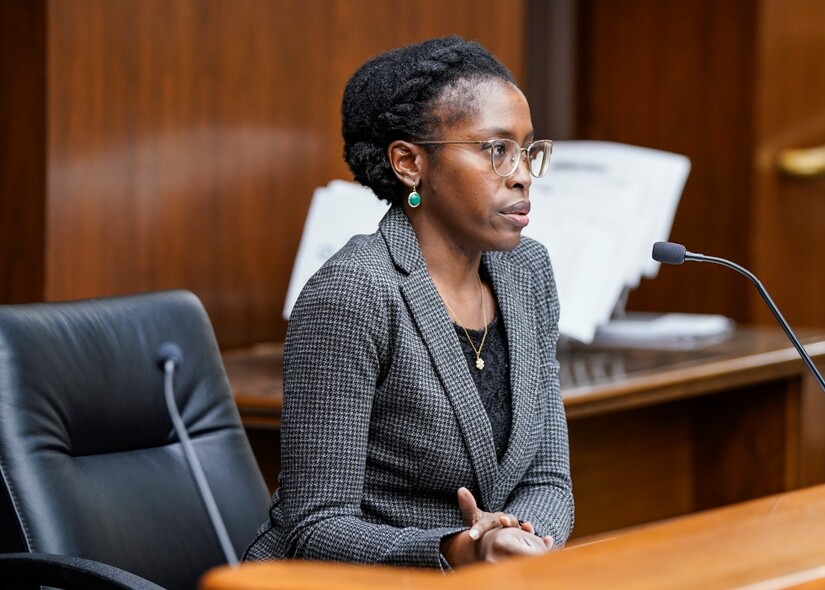Image

By Tom Akaolisa, MinneapoliMedia
MINNEAPOLIS, MN - In an exclusive interview as part of MinneapoliMedia's "Meet Your Legislator" interview series, Representative Esther Agbaje of the Minnesota House shed light on her passionate work regarding housing affordability, particularly the impactful down payment assistance provisions within the recent housing legislation. Interviewer Tom Akaolisa engaged with Rep. Agbaje to delve into the program's early success, long-term sustainability, and its broader implications for Minnesota communities.
Tom Akaolisa: Representative Agbaje, thank you for joining us today. Your down payment assistance program has seen significant early traction. Could you provide specific demographic data on the beneficiaries so far and how well that aligns with the program's original equity goals?
Rep. Esther Agbaje: Thank you, Tom. I'm truly pleased to be part of this series. In the initial phase of the down payment assistance program, administered through the Minnesota Housing Finance Agency, we've already assisted hundreds of families. Notably, the Community Impact Program, managed by the Midwest Minnesota Community Development Corporation (MMCDC), has helped 831 new homeowners as of March 2025. Of these, 91% identify as BIPOC homeowners, and the average household income of these new homeowners is approximately $83,000. This data indicates that we are effectively reaching the intended demographic, ensuring access to homeownership for those who have historically faced barriers.
Tom Akaolisa: With the housing market constantly evolving, what plans are in place to ensure the long-term sustainability of this program? How do you envision it adapting over time to remain effective?
Rep. Esther Agbaje: We are actively working to ensure the program's longevity. This year, we updated the policy to focus eligibility on the home buyer rather than the entire household. We also shifted the assistance to a maximum of 10% of the home's purchase price, instead of a fixed $32,000 cap, providing more flexibility given current housing prices. Looking ahead, we need to explore further policy adjustments and, crucially, secure a permanent funding source, which remains a key priority.
Tom Akaolisa: Substantial funding is essential for the program's reach. How are you working to ensure these resources are distributed equitably across Minnesota, addressing both urban and rural housing needs?
Rep. Esther Agbaje: Our approach in this year's housing bill was to strategically invest in existing programs that facilitate home building and affordable housing development statewide, benefiting both the metro area and rural communities. This effort garnered bipartisan support. We allocated funds to initiatives like the Workforce Development Challenge Fund and the Greater Minnesota Housing Program. Recognizing that approximately 30% of Minnesotans are renters (and up to 50% in Minneapolis and St. Paul), we also dedicated resources to rental assistance.
Tom Akaolisa: The down payment program is a cornerstone of this bill. What are the core provisions within the broader housing legislation that directly tackle the shortage of affordable housing in the state?
Rep. Esther Agbaje: Beyond the down payment assistance, the housing budget bill prioritizes increased funding for established programs focused on building housing. The Challenge Program and the Greater Minnesota Housing Program are key examples. We anticipate that these investments will lead to new housing developments across the state within the next one to two years.
Tom Akaolisa: The program has specific eligibility criteria. Are there any concerns that certain populations, such as undocumented residents or recent immigrants, may face barriers? What steps are being taken to address these potential challenges?
Rep. Esther Agbaje: For the down payment assistance program, eligibility is primarily focused on the individual home buyer and their history of homeownership. The criteria stipulate that the buyer's parents or guardians must not have owned a home. While this targets first-generation homebuyers, we acknowledge that other individuals facing financial hardship, including some undocumented residents or recent immigrants, might not meet this specific criterion. However, as long as an individual is a Minnesotan and completes the required homeownership training, they should be eligible if they meet the first-generation homebuyer requirement.
Tom Akaolisa: How do you anticipate this program influencing the broader Minnesota economy in areas like intergenerational wealth building, neighborhood stability, and local job markets?
Rep. Esther Agbaje: We are optimistic that this program will significantly contribute to community stability, safety, and the creation of intergenerational wealth. Homeownership can be a powerful catalyst for these outcomes. However, it's crucial to recognize that this is one component of a larger economic ecosystem. Homeowners also need resources for maintenance, job security, education, and active community involvement. This program aims to provide a crucial first step for those historically excluded from homeownership.
Tom Akaolisa: In terms of oversight and accountability, what mechanisms are in place to track how funds are spent and ensure their effective use?

Rep. Esther Agbaje: The funds are administered through the Minnesota Housing Finance Agency and the MMCDC. Both entities have robust processes in place. Funds are only released when a qualified buyer is ready to close on a home, having completed financial and homeownership training and having their eligibility verified. This ensures that the money is directly used for its intended purpose – facilitating home purchases.
Tom Akaolisa: What further legislative actions do you believe will be necessary to deepen Minnesota's response to the ongoing housing crisis?
Rep. Esther Agbaje: Zoning reform is a critical area we need to address to make it easier to build more diverse and affordable housing options across the state. We are exploring establishing baseline state standards for zoning requirements, while allowing cities to implement stricter regulations if needed. While broader zoning reform faced challenges this year, we are hopeful about enabling the Minnesota Housing Finance Agency to incentivize development applications that prioritize housing density and increased zoning capacity. Additionally, I am advocating for legislation to curb the acquisition of single-family homes by large corporations, aiming to increase homeownership opportunities for individuals and families.
Tom Akaolisa: With high interest rates and rising home prices, how will this program continue to serve its purpose? Is flexibility built in to adjust based on market changes?
Rep. Esther Agbaje: We have incorporated flexibility into the program. Capping the down payment assistance at 10% of the purchase price, with a maximum purchase price around $500,000, allows the program to adapt to varying market conditions. This can also be combined with other down payment assistance programs. Furthermore, removing the credit score requirement broadens access to individuals who may have faced barriers due to credit history.
Tom Akaolisa: In your view, how does this bill, particularly the down payment provision, support broader Community Development goals statewide?
Rep. Esther Agbaje: Ultimately, this program aims to empower more Minnesotans to build generational wealth, foster community stability, and contribute to thriving neighborhoods. By increasing homeownership, especially when coupled with efforts to build more housing, we can create communities where people feel safe, have access to quality education, and want to live and invest.
Tom Akaolisa: The program places a special focus on first-generation homebuyers. What unique challenges did they face, and how does this legislation work to level the playing field?
Rep. Esther Agbaje: First-generation homebuyers often face significant hurdles due to the historical inequities in housing access. They typically lack the familial wealth or financial support networks that repeat homebuyers may have. This legislation directly addresses this by providing crucial down payment assistance to individuals who may have the income to manage mortgage payments but lack the upfront capital due to their family's history of not owning property.
Tom Akaolisa: How did local or community-based organizations factor into the success of this program? Are key partnerships in place to help connect eligible residents to these resources?
Rep. Esther Agbaje: Our partnership with the MMCDC, a vital Community Development Financial Institution, has been instrumental. They collaborate with numerous non-profits and organizations statewide to reach diverse communities, provide financial education, and facilitate access to the program. This grassroots approach ensures that those who need the assistance most are aware of and can access these resources. The MMCDC's success in assisting over 800 households since last fall demonstrates the effectiveness of these partnerships.
Tom Akaolisa: How does this legislation strike a balance between the housing needs of large urban centers like Minneapolis and St. Paul and the more rural communities in Greater Minnesota?
Rep. Esther Agbaje: The MMCDC, while based in northwestern Minnesota, actively works with partners in urban areas like St. Cloud and other rural parts of the state. The program's design intentionally avoids being solely focused on urban or rural needs, instead prioritizing individuals who meet the eligibility criteria regardless of their location.
Tom Akaolisa: If the current program proves successful, is there room or intent for expansion? What would that process entail legislatively and financially?

Rep. Esther Agbaje: Absolutely. Given the program's early success, our goal is to expand its impact by securing a consistent, recurring funding source. This would provide greater stability and allow more eligible Minnesotans to benefit from the program, potentially in conjunction with other down payment assistance initiatives.
Tom Akaolisa: Considering the broader discussion around the effective use of public funds, how would you define and measure success for this program? What metrics are most important to you in evaluating its long-term impact?
Rep. Esther Agbaje: While the number of individuals who successfully purchase homes through the program is a key metric, the long-term success will be measured by the number of people who are able to sustain their homeownership. Moving forward, I believe it's important to explore resources and support systems to help first-time homeowners with ongoing maintenance and upkeep, ensuring their long-term stability.
Tom Akaolisa: Representative Agbaje, thank you for this insightful conversation about a program you are clearly deeply committed to. We appreciate you sharing the details and look forward to following its progress. Would you be willing to return in the future to discuss the program's ongoing impact?
Rep. Esther Agbaje: Absolutely, Tom. I would be delighted to come back and share updates on the program's success. We've already seen significant positive impacts, and I'm eager to see how it continues to help Minnesotans achieve their homeownership dreams.
Tom Akaolisa: Thank you again, Representative. We wish you continued success in your legislative endeavors.
Rep. Esther Agbaje: Thank you, Tom. It was a pleasure.